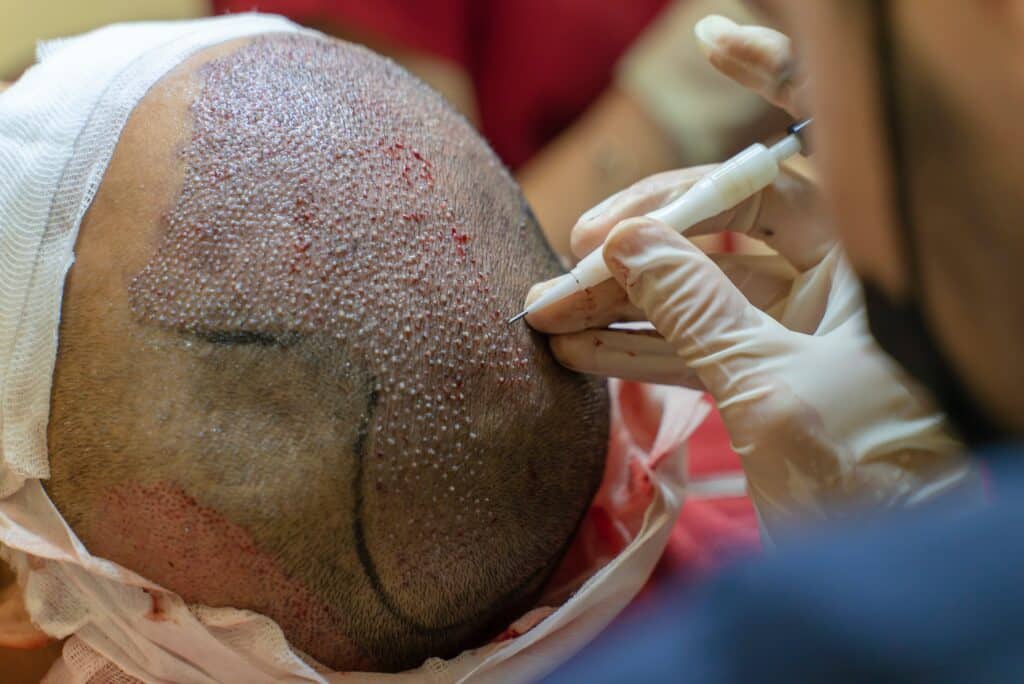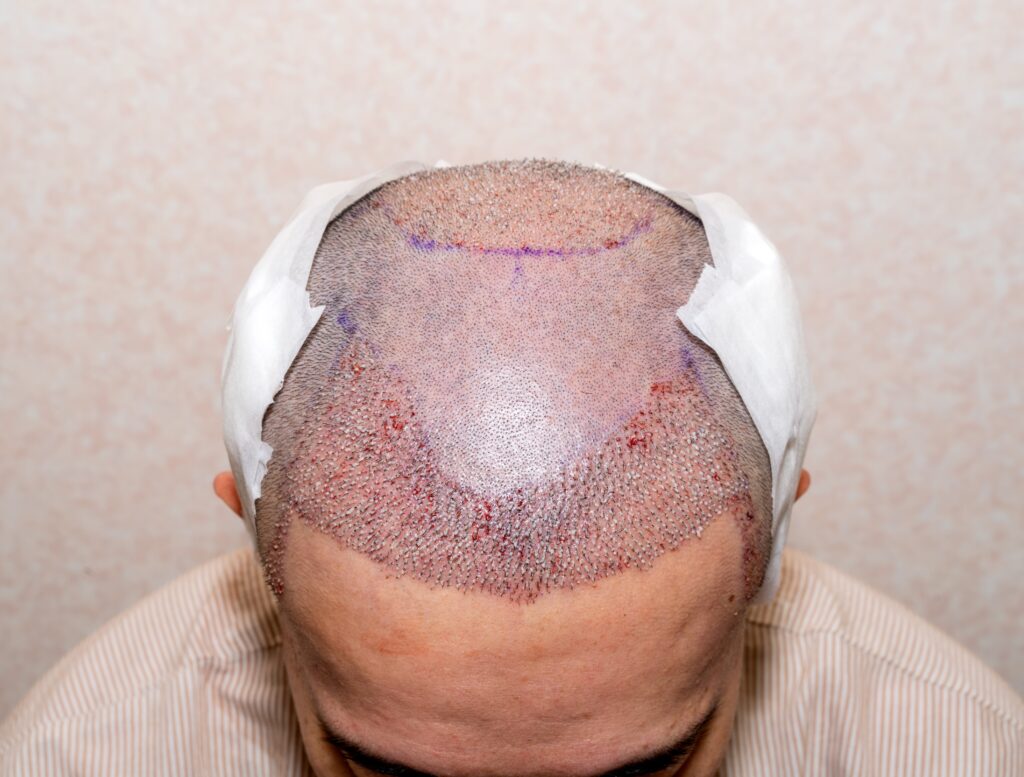A hair transplant involves the specialist making multiple incisions in the scalp. While this may sound like a simple process for most people, some may find the thought scary. In particular, anyone with trypophobia, and especially hair transplant trypophobia will find the idea of having many small incisions in the head scary. This is a type of fear of or aversion to clusters of small holes.
In this article, we’ll explore the phenomenon of hair transplant trypophobia, including causes, common concerns, and how to deal with it.
What Is Hair Transplant Trypophobia?
On a general note, Trypophobia is a fear of patterns of closely packed bumps or holes. This can lead to feelings of distress or even disgust when looking at surfaces with closely packed small holes. Some people may feel helplessness while others may have goosebumps or itchiness. Other common reactions include shortness of breath, dizziness, trembling, and sweating.
What Causes Trypophobia in Hair Transplant?

We do not know the exact cause of Trypophobia, but triggers include any closed pattern of small holes. This may include sponges, honeycombs, sunflowers, bagels or bread covered in seeds, slow of some shoes, and fruits with small seeds like kiwis and strawberries.
The feeling a person with trypophobia feels when they see a sponge for instance, can be similar to the one they have when they see the small incision of a hair transplant. During an FUE hair transplant, the surgeon uses a special device to create small holes in the head using tiny incisions. For someone with trypophobia, the thought or sight of these small holes can lead to discomfort, fear, or disgust.
In the donor areas of the scalp, the surgeon uses a handheld micromotor for extracting hair follicles. The procedure creates small holes that vary in size depending on the device the surgeon uses. In most cases, the holes can vary between 0.85mm to 0.95mm. Since these holes are located at the sides and back of the head, they can trigger trypophobia in the first few days after surgery.
Similarly, the recipient or balding regions of the hair where the grafted follicles are placed also require the creation of tiny holes. These holes are where the extracted hair follicles will be placed. Although the patients usually do not see these after transplant, those with trypophobia tend to have issues with the thought of having these holes.
What Do Hair Transplant Holes Look Like?
After undergoing a hair transplant procedure, the patient’s head may be covered in small holes. However, this only happens when the surgeon uses outdated techniques or the wrong micro punch tool. The latest techniques help prevent the transplant holes from looking so obvious. Usually, the area will look as if it has been grazed, and turn into slight red scabbing as the wounds and grafts heal.
Extracting hair transplant holes and trypophobia are usually linked. However, modern techniques help in reducing the risk of triggers by reducing the size of holes from the incision. The micro punches hair transplant surgeons are now mainly using ensure that you do not experience any significant pain. They allow to have a minimum amount of holes in the head. These may not trigger symptoms for anyone with trypophobia and only take a few days to heal.
Which Hair Transplant Technique Triggers Trypophobia the Most?

The hair transplant technique that triggers Trypophobia the most is the Follicular Unit Extraction FUE. During this process, the surgeon transplants hair by making small punctures into the scalp. This happens in both the donor site where the extraction of the hair follicles takes place, and in the recipient areas where the hair is thinning. The scars created in these look like tiny dots visible on a shaved head. These are the ones that can trigger hair transplant trypophobia.
Can Trypophobia Affect the Hair Transplant Decision?
For those with trypophobia, a hair transplant decision can be a heavy one. Although this is a widely sort after solution for hair loss, you may be concerned that the transplant may not be suitable for you. However, it is still possible to undergo a hair transplant surgery even if you have trypophobia.
The surgeon will usually recommend several ways to overcome hair transplant trypophobia, including feelings of fear, distress, and anxiety. In some cases, the surgeon can advise that the bandage on the sides and at the back of your head is kept on for longer to help you avoid seeing the holes in those areas.
How To Deal with Hair Transplant Trypophobia?
Thinking of how to deal with hair transplant trypophobia can be intimidating, but several remedies can help:
Exposure Therapy
With exposure therapy, you are allowed to face your phobia in a safe and supportive space. This therapy aims to help you alter how you react to trypophobia triggers. This can help minimize the anxiety, fear, or distress that you encounter in the face of clustered holes.
You may also be shown photos of hole clusters or patterns while being guided on how to respond to them. The level of exposure is increased gradually until you can touch or hold an object that would normally trigger trypophobia, such as a sponge.
Cognitive Behavioural Therapy (CBT)
CBT is an effective approach for dealing with trypophobia by allowing you to manage the related fear and anxiety. During CBT sessions, a therapist will help you alter the actions or thoughts that cause trypophobia symptoms. By understanding the way your thoughts or actions lead to trypophobia symptoms, you can effectively change your thinking patterns.
Medication
In cases where the symptoms of trypophobia are related to a mood disorder like anxiety or depression, the doctor may prescribe medication. For instance, the doctor may prescribe anti-anxiety medication before having a hair transplant to prevent triggers.
Breathing Exercises and Meditation
Breathing exercise is a simple and effective way of calming your mind and body. By taking deep breaths, you can slow down your heart rate and relax to avoid or slow down triggers. Meditation can also help to reduce anxiety disorder symptoms and soothe the nerves.
Look for before and after photos

Looking at before and after photos of successful hair transplants from your doctor can significantly reduce anxiety. These photos will show the final results – typically a full head of hair with no visible signs of the tiny transplant incisions. Seeing the positive outcome can reassure you that the temporary presence of small holes is a minor step towards a permanent hair loss solution.
Book a Consultation
Cosmedica is a top hair transplant clinic in Istanbul, Turkey. With the use of the DHI Sapphire Method, the experienced hair transplantation specialist Dr. Levent Acar helps you achieve a faster healing time with an improved growth rate.
The procedures also ensure that the holes created during transplant are tiny and bearable even for people with trypophobia. With the faster healing times, you can be sure to go through the entire process and go back to your daily life without triggering trypophobia symptoms. You also get all the necessary support and guidance to help you have an easier time during healing.
